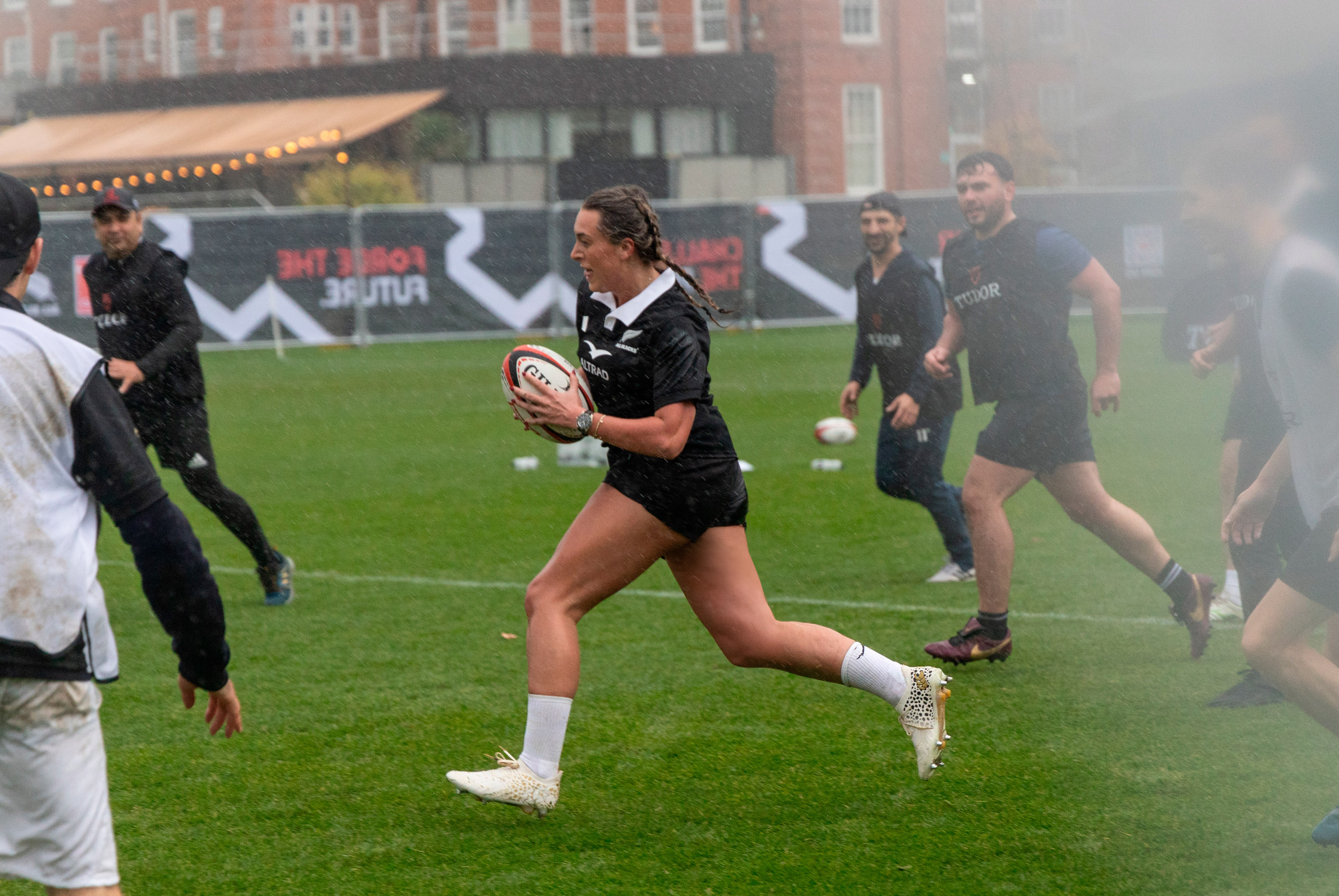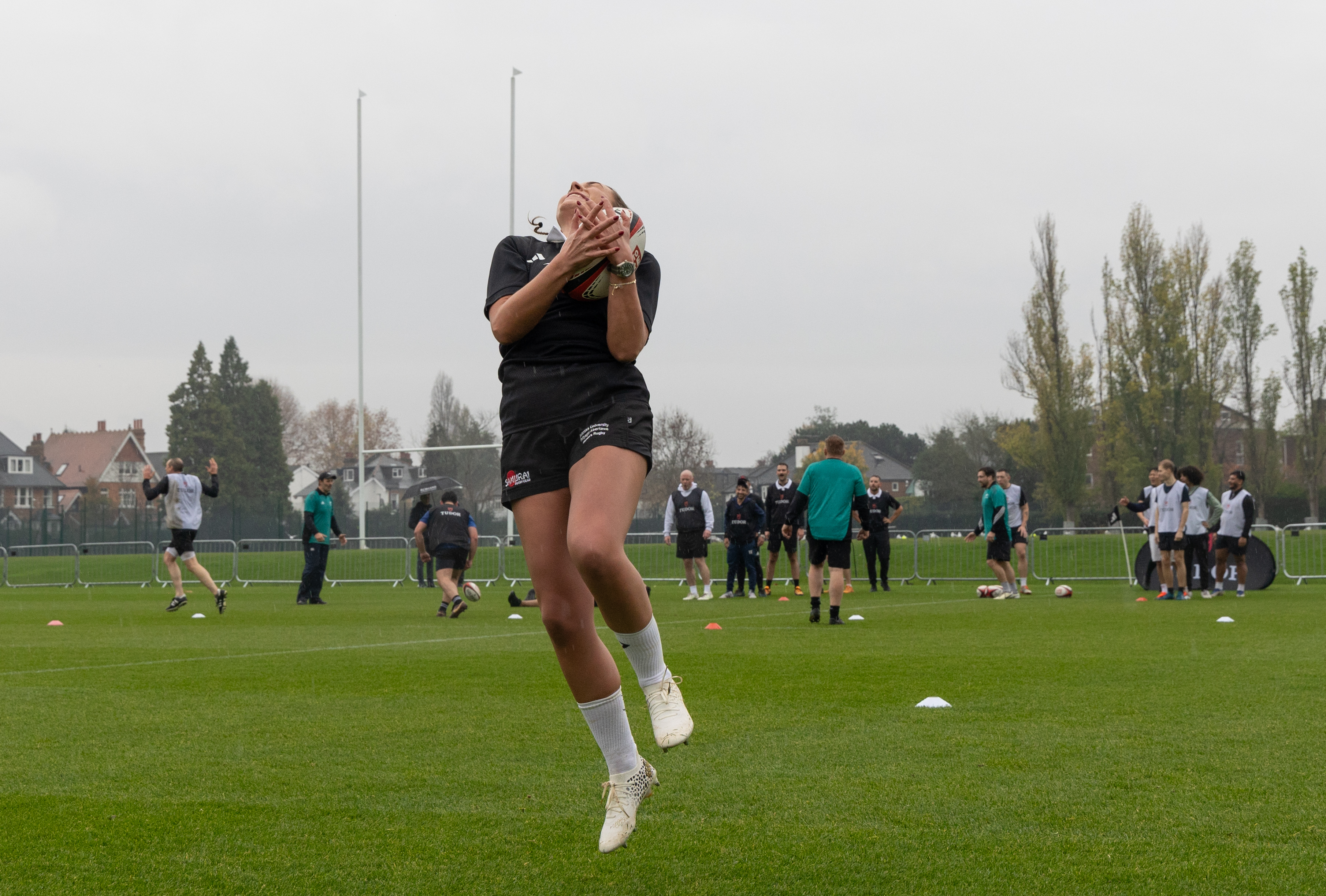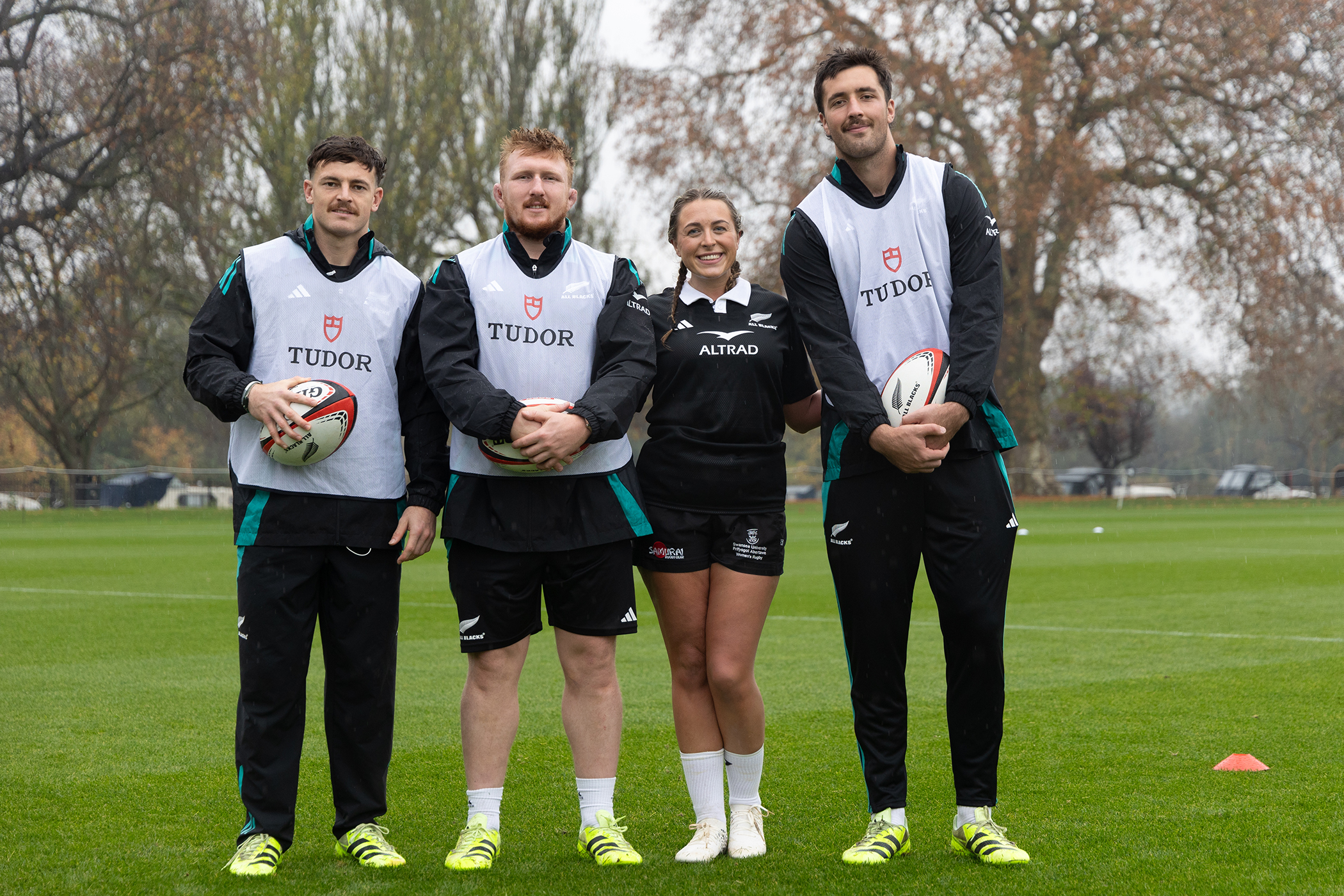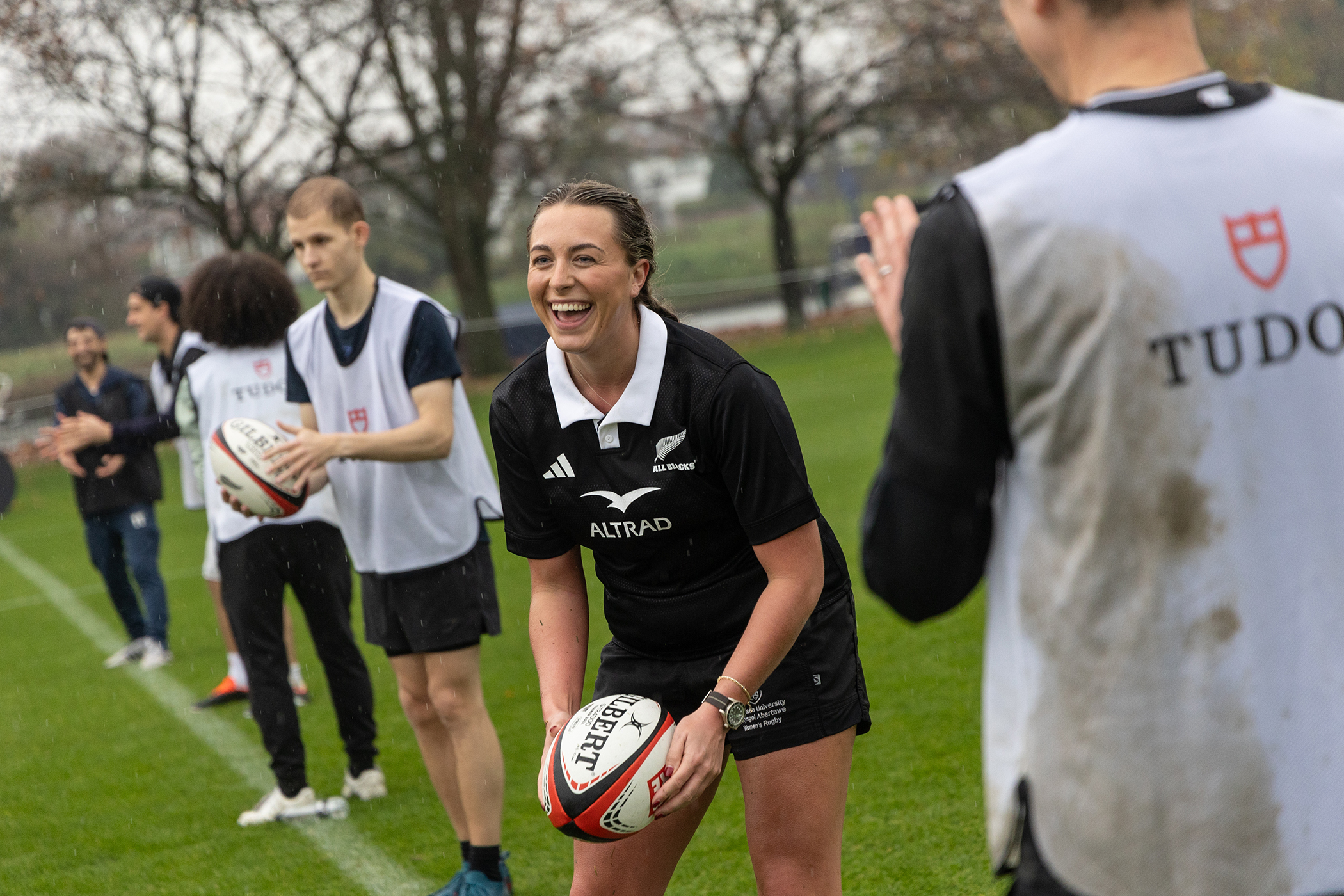On Friday, the day before the All Blacks faced England at the Allianz Stadium in Twickenham, I found myself standing on a waterlogged training pitch in southwest London with the All Blacks. I had been invited to join a training session with three members of Saturday’s matchday squad: Fletcher Newell, Josh Lord, and Leroy Carter.
It was, in theory, an opportunity to experience the intensity and precision that define the All Blacks environment. In practice, it was also a chance for three elite athletes to assess the limits of my fitness and rugby prowess while I attempted to remain upright in conditions that would have prompted Noah to consider shipbuilding.
The Met Office had issued an amber weather warning, forecasting 44mm of rain. I believe the full 44mm landed directly on me. The pitch was drenched, the air was thick with cold rain, and every step produced the sort of splash you would expect when wading through a pond. It was, in other words, not ideal weather for rugby. Or walking. Or existing. The team at Tudor, who sponsor the All Blacks, had given me a Tudor Black Bay 58 watch to wear for the training session, which survived the rain and training session remarkably better than me.
Despite the conditions and the looming fixture against England, the three players were calm. The England team had been visited by US Open winner Emma Raducanu for a training session, and I felt unworthy by comparison. Nonetheless, the All Blacks were focused and impressively generous with their time.

The first drill of the morning was kicking over the posts. Newell and Carter demonstrated with unnerving ease, sending the ball sailing through the uprights with the kind of smooth, economical technique that is the product of thousands of repetitions, while explaining how to replicate their technique. They made it look deceptively simple, even in torrential rain. I realised, somewhere around the time that Carter passed me the ball to have a turn, that it would have been helpful to have been concentrating more on what they were saying and less on their (for the record, very impressive) thighs. I stepped forward with considerably less natural elegance, fully aware that the eyes of three international players were upon me.
The ball left my boot with enthusiasm but very little direction. The players offered supportive feedback, delivered in that polite, diplomatic tone parents reserve for children’s art work. Newell assured me that the connection was “clean,” though his eyebrow twitched slightly, suggesting that “clean” was perhaps being used as a very nice way of saying “you managed to kick the ball”.
We moved on to grubber kicks – small, skidding kicks designed to thread through defensive lines. Carter, who has the quickness and precision of someone who probably grubbers balls accurately in his sleep, demonstrated the technique flawlessly. His kick zipped along the ground with perfect weight and spin.

Mine did not. My first attempt ricocheted off my foot. The second travelled at a 90-degree angle to my intended target. The third achieved a respectable forward roll for approximately three metres before surrendering. But, after regaining my concentration, I managed to get the technique down well enough for Carter to suggest we try a harder skill: catching the ball from a high kick.
It was during the grubber drill that I fully appreciated the contrast: the All Blacks, training with precision the day before taking on England at Twickenham – a match steeped in rivalry and pressure – while coaching a thoroughly-soaked amateur. But their patience was unwavering. They offered small adjustments, gentle guidance, and the sort of composed encouragement that reflects not only skill but character.
Now, in an attempt to not completely write off my own abilities: I played rugby to a half-decent standard for five years, but stopped in 2019. So I knew what I was meant to do, but less sure my arms would remember. Carter sent towering kicks into the grey, rain-heavy sky, each one disappearing briefly into the clouds before plummeting back toward earth. To my surprise – and, judging by their expressions, to the surprise of all three players – I actually excelled at this. I caught all but one cleanly, despite the rain stinging my face and having lost a contact lens in the mud, and the ball spinning like a rogue satellite. “Nice,” Newell said, and I believe he meant it. It was a fleeting but sincere moment of pride, and it gave me the confidence for what happened next.
Because then came the moment I will be recounting for the rest of my life: we played a short game, and I scored a try.
Carter nudged a perfectly-weighted kick through the defensive line and between the posts, and I took off after it. “Took off” may be generous; I moved with the urgency of someone who knew this might be their only opportunity to achieve any moment resembling sporting excellence.
As I slid toward the ball, rainwater splashed up into every possible part of my body. It was less a dive and more a belly flop over the try line, skidding across the ground like a seal performing a trick at Sea World. But somehow, miraculously, I managed to ground the ball cleanly. It was a try. A legitimate, indisputable try, in front of three actual All Blacks. In that moment, I felt heroic, triumphant, borderline mythic.
The players reacted generously. Even Lord, the quiet and reserved second row who towers so far above me that I experience mild altitude discomfort when speaking to him, cracked a smile. This brings me to an essential point of clarification: Josh Lord is an extraordinarily tall man. Being coached by all two metres of him is like seeing a lamppost develop opinions. I spent most of our interactions speaking to his belly button, and I felt as if he had to duck every time a plane flew overhead towards Heathrow.

Following my moment of sheer sporting brilliance, the session escalated to something more intimidating: the Bronco test. For the uninitiated, the Bronco is a shuttle-run fitness test beloved by rugby coaches and feared by every player required to complete it. The All Blacks use it to measure conditioning. I used it to measure how badly my lungs have been damaged by a misspent youth in the smokers’ area outside nightclubs.
With England looming the next day, Newell, Lord, and Carter wisely opted not to participate. They were preserving energy and maintaining focus for Twickenham. I, however, had no such match to prepare for, and thus no excuse to avoid the suffering. The players positioned themselves as supervisors, guarding each cone I had to reach before turning and running to the next. The problem with Lord standing on the furthest cone is that his height made him look a lot closer than he ever was.
I set off, splashing across the pitch like Bambi, back and forth, forcing light conversation at each stop with the players in an attempt to use it as an excuse to stop for a second, but they saw straight through me. Every change of direction felt like a philosophical negotiation between my brain and my legs. Lord offered occasional words of encouragement, and it is difficult to describe the emotional effect of being spurred on by a man so large only his lower half was affected by the weather.
By the end of the Bronco, I was soaked, exhausted, and deeply grateful that professional rugby was a career path that I didn’t pick. And, demonstrably, hadn’t picked me either.
And yet, that exhaustion was accompanied by a new appreciation for what the All Blacks balance daily: the undeniable seriousness of preparing for Test rugby, blended with the humility and humour that are foundational to their culture.

On Friday, in the worst conditions London could muster, I saw the All Blacks not as untouchable legends, but as professionals who work relentlessly, care deeply, and maintain standards that are lived rather than spoken. They were focused and dedicated without ever needing to announce it.
I left the field drenched, aching and bruised, carrying with me the muddy, unforgettable certainty that I had witnessed something special: the All Blacks at work, on the eve of Twickenham. But, in fairness, they had witnessed something pretty special too – the absolute peak of my athletic career.
Photographs by Andy Hall for The Observer

